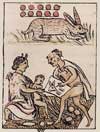Codex BorgiaCodex Borgia is preserved in the Apostolic library at the Vatican in Rome, Italy. It was constructed of animal hide and covered with a white plaster-like foundation upon which the figures were painted. It was folded so that it could either be stored compactly or opened to reveal all of the pages of one side. Codex Borgia features a page by page portrayal of the various divisions of the sacred 260 day calendar or tonalpohualli (toe-nall-po-wha-lee). (For more information go to www.famsi.org/research/pohl/jpcodices/index.html) Pages 61-70 illustrates the division of the calendar into trecenas, twenty "months" of thirteen days. A different god presides over each trecena. Diviners used the calendar to foretell the future of children born under each of the 260 day signs. To look up your own day sign in the Nahua Calendar go to: http://www.azteccalendar.com The supernatural patrons of diviners who used the codices were five male and female couples called the Maquiltonaleque and the Cihuateteo appearing on Borgia 47-48, together they formed part of a larger group of spirit beings called Tzitzimime (Tzitzimitl, sing.) In manipulating the books, male practioners invoked the spirit forces of their patrons through the tips of their fingers which they addressed as the "Maquiltonaleque." Maquil means five, signifying the numeral in each of their names. The Cihuateteo were said to be the spirits of women who had died in child-birth. They were patrons of mid-wives and curers.
We know that Codex Borgia was used by palace diviners, mid-wives, and curers as a
means of invoking the prophecies of the gods. A diviner gives the prophecy for the birth of a child on the day
10 Rabbit in an illustration from the Florentine Codex.
|







